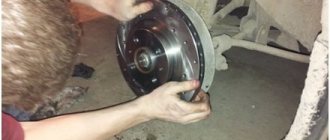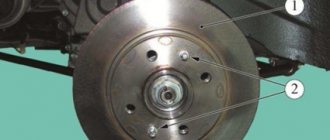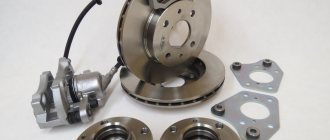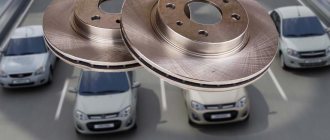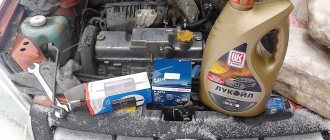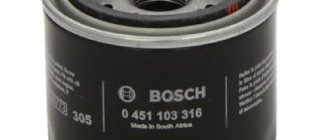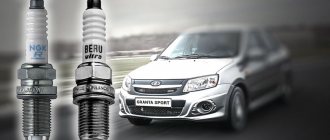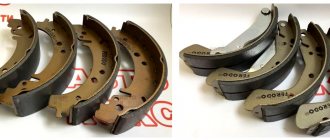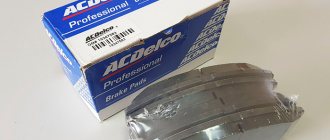Brake discs are replaced when their thickness becomes less than permissible (17.8 mm). Replacement is also carried out if they are damaged (cracked), unevenly worn, or when they are a source of runout. Let's figure out which brake discs are best to buy for the Lada Granta, Kalina and Priora family of cars
How does the Lada Granta brake system work?
The working brake system is dual-circuit. This was done to ensure fault tolerance. If one of the circuits malfunctions, the second will perform braking, albeit with less efficiency. The first circuit is located on the front right and left rear wheels, and the second circuit is on the front left and right rear wheels.
The front brake discs on the Lada Granta are ventilated discs. When you press the brake pedal, the pressure in the system increases, the piston moves, pressing the pad against the disc.
To reduce cost, the rear brakes are drum brakes. They have a mechanism for automatically adjusting the gap between the drum and the pads. The disadvantage of this design is instability to moisture and souring of the brake cylinder. Only replacement helps. The Lada Granta Sport uses rear brake discs, but they are not ventilated.
The engineers took the handbrake from the VAZ-2109 car and did not modify it in any way. It also doesn't hold well and needs to be tightened frequently. To do this, there is an adjusting nut on the handbrake lever. The design is very primitive - a cable runs from the lever to the rear drum brakes.
Standards from manufacturers
It is believed that the wear of brake discs varies from company to company. Here is a table of some permissible thickness values for different car brands:
- For example, on some Nissan models and Renault Logan it is considered that the standard is met at 22 mm, but not lower than 20 mm.
- VAZs are divided into two subtypes: ventilated ones are aimed at 17.8 mm in thickness, and non-ventilated ones at 10.8 mm.
It is important! Car manufacturers allow allowed wear of no more than 1 mm. Abrasion exceeding the permissible norm requires urgent replacement of the disk.
Why is it important to find out whether the brake system is worn out in advance? There are many cases when a thinned disk became heated while driving, and when suddenly cooled (puddle, snowdrift) cracked. This combination of circumstances leads in the worst case to an accident, and in the best case to a complete stop of the car.
What are brake discs for?
The essence of the brake disc's operation is to convert the kinetic energy of the vehicle's movement into thermal energy by friction against the pads. When braking is completed, the heat is dissipated. The main requirements are resistance to mechanical and thermal loads.
The disk itself consists of two parts - the rotor and the central part. It is the rotor that the pads come into contact with when braking. This is the heaviest part cast from cast iron. Sports car brakes have holes on the rotor to allow more efficient air flow to the surface and better cooling.
The central part is attached to the wheel hub. On ventilated brakes, this is where the holes are located. This part should not transfer heat to the wheel bearings, so it is made of heat-intensive metals - aluminum, titanium. The rotor is soldered to the central part or represented as a separate component. On cheap machines, the central part is cast iron and is combined with a monolithic rotor.
Reasons for replacing spare parts
One of the main reasons for replacing brake discs is natural wear and tear. In addition, it is recommended to install new parts instead of old elements in the following cases:
- premature failure of discs, which can be determined by deterioration in the quality of braking of the car;
- damage to product surfaces;
- deformation of spare parts.
Attention! In any of these cases, it is recommended to replace the brake discs to avoid a dangerous situation while the vehicle is moving.
What are brake discs?
There are three types of brake discs:
- Solid. The working blade and the part adjacent to the hub are monolithic. There is no cooling.
- Ventilated. There are fins there that form channels for cooling. Due to them, the best cooling is achieved.
- Composite. The central part adjacent to the hub is cast from aluminum or titanium. The structure is prefabricated. The second element is a cast iron ring. In this case, the weight is significantly reduced and thermal stability is improved. Heat transfer to the hub is minimal.
Brake discs on Lada Granta
Brake discs on the Lada Grant are divided into 4 groups by type:
- Smooth - used more often than others. The working surface is completely smooth.
- Perforated - through holes are applied across the entire area of the disk, improving cooling and reducing the weight of the structure.
- With radial notches - special “ditches” are designed that remove waste particles outside the working area.
- Perforated with notches - a combined version of the second and third. A rare species that has the best qualities of both specimens.
Discs are made from cast iron and ceramics.
Cast iron
Cast iron brakes are popular and have been used in almost all budget cars for a long time. Cast iron is durable, heat-intensive and not subject to temperature deformation. Among the disadvantages are weight and long cooling time. But the aesthetics of these discs are not the best - they are susceptible to oxidation, rust quickly, and have to be periodically tinted. It is better to install brake discs made of this metal on the Granta.
Don't underestimate cast iron just because it's not used in expensive cars. It has found wide application in railway equipment - trams, metro trains, diesel locomotives. The brake pads of the Russian ED4M are made of cast iron. The load on this metal is truly monstrous and frequent - on average in Moscow, a train slows down once every 2-3 minutes.
Ceramic
They are used on expensive cars that are designed for sports. They have low noise and vibration levels, are more durable and perform well at high temperatures. They are much lighter in weight than their cast iron counterparts because they do not contain metal.
Minuses:
- price;
- low efficiency when the part is not heated;
- creaks due to design features.
Ceramics are intended for lovers of aggressive driving with frequent braking. For quiet driving around the city, on the highway and on country roads, it is clearly not needed, especially for such a price. In addition to sports cars, ceramics are used in aviation.
Non-ventilated
The non-ventilated disk is the most primitive and widespread. It is a monolithic device with an inseparable rotor and a central part. Most often made from cast iron. Found application in inexpensive and low-power cars. Due to the lack of ventilation, it heats up quickly and cools down slowly. The efficiency is significantly lower than that of a ventilated one. However, you shouldn’t consider it completely bad - most often, just such a brake will suit the average user.
Ventilated
Ventilated is the most common type of front axle disc on modern cars. It has a little less weight, good cooling. The actual device is that it is two disks joined together with a cavity in between. The plates are covered with through holes.
Now in Russia, about 70% of all new cars are supplied with ventilated front brakes.
What is the difference between regular and sports
First of all, the difference is in price and purpose.
Requirements for conventional disks are low price, heat capacity, efficiency in normal mode. They are intended for ordinary trips around the city and on the highway at a speed of 60-110 km/h, so there is no point in installing more expensive ones. Conventional ones are made of cast iron. The front axle is ventilated, but the rear axle is not. The weight and how long the part cools down does not matter. It is better to install brake discs of this type on the Granta.
Sports ones are designed for high speeds and constant braking. They should be light, cool quickly, and produce maximum friction between the pad and disc. Such brakes are very expensive, but they also last longer. The main arguments why the average driver should not buy them are the high cost and ineffectiveness when cold. Typically sports brakes are vented ceramic.
Determining wear and tear at a service station
External signs of brake disc wear are confirmed by removing the wheels and visually inspecting them in a workshop. Nothing can replace the professional approach of masters of their craft:
- First of all, they pay attention to the gutter machined by the manufacturers. The disappearance of this groove indicates that the metal has worn down to the control mark, which means it’s time to change it.
- The second proven way to measure the layer of a part is to measure its thickness with a caliper. The vehicle operating manual now for many brands indicates the parameters of the permissible thinning norm. In accordance with it, the critical level of wear can be accurately measured.
- Deformations of auto parts can be seen with the naked eye. These are cracks, deep scratches and other surface defects. In this case, you can replace the part, otherwise irreparable things may happen. Shallow grooves not exceeding 1 mm, if the metal layer is sufficiently wide, are left by grinding on a machine.
- A micrometer is used to measure disk runout. Exceeding the level of 100 microns. implies future vibration while driving. Such indicators will negatively affect the brake mechanism, in particular, will lead to rapid wear of the pads.
All individual moments are difficult to describe, so a qualified approach is needed. Our technicians assess the condition of the car as a whole and, if necessary, replace other parts. Prevention also includes lubricating the caliper, or cleaning it from excessive oiling, and more.
What kind of wheels are installed on the Lada Granta?
The system on all cars is approximately the same. The front brakes are ventilated disc brakes, the rear brakes are drum brakes. Exceptions are the sports versions of these cars. On the Lada Granta Sport the rear brake discs are ventilated, there is no drum.
| R13 | R14 | R15 | |
| Where were they placed? | "Kalina", "Granta" with 8-valve engine | "Priora", "Kalina" (8- and 16-valve engine), "Lada Granta" and "Granta" liftback only for a 16-valve engine | "Granta Sport" and "Kalina Sport" |
| Peculiarities | The disc is significantly smaller than the anther | Disc of the same size with boot | Installed only on sports versions of cars |
| Acceptable wheel size | R13 and more | R14 and more | R15 and more |
If you are choosing rims for your wheels, look at the size. It should be the same, no less. Brake discs for Granta with wheels 14 are suitable only for sizes R14 and R15.
Factors influencing the wear rate of discs
- curb weight of the car: the greater the weight, the thicker and more massive the calipers;
- material: cast iron is used as a basis - a mixture of steel and carbon. Modern technologies make it possible to use a number of chemical elements to increase the strength of the material. For example, molybdenum powder. However, the use of impurities leads to an increase in the cost of the part;
- frequency of technical inspection;
- compliance with the rules for using a car;
- style and manner of driving a vehicle;
- climatic temperatures, features of the geographical region.
Which discs are better for Grants in different conditions?
Three different types of brake discs are installed on the Granta. Often users install similar parts from foreign cars to speed up the ride or to save money.
In the city and on the highway
Under normal operating conditions, factory cast iron discs or any other equivalents are suitable. If you have the original 13s and are not enough, change to a 14th size. It's easy to change them, and the car will brake much better.
Remember that you have an inexpensive sedan, not a race car. Do not overheat the brakes and if you drive through a water obstacle in the form of a puddle, dry them by briefly pressing the brake pedal. It doesn't make sense to pay more for ceramics for quiet use.
For lovers of fast driving
If you like to race, think about good brakes. For this purpose, 15-size perforated wheels with grooves or other sports wheels are suitable for the Granta. If you have a passion for this car and you are tuning it, install ceramics. Although it is expensive and needs to be warmed up, it is best suited for sports use.
Analogs
The cost of original components is an order of magnitude higher than analogues. Therefore, the choice of many vehicle owners falls on substitutes. The most advantageous offers:
| Name | vendor code | Cost, rubles |
| A.S.P. | 2702220 | 2 thousand rubles. for 1 piece |
| B.M. | BDV 885 | 1 thousand rubles for 1 piece. |
| Hella | 8DD355109331 | 1.6 thousand rubles for 1 piece. |
Conclusion
Homemade methods for eliminating defects solve the problem for a while. Part with car parts worth 10–15 thousand rubles. expensive and unfortunate. Someone manages to “extend” the pads by soldering them onto the pads. However, homemade pads tend to come off. A thinned disc can collapse at the most inopportune time.
Advice! Be sure to check the condition of the brakes at a service station and have any discrepancies resolved professionally. This way you can save your life and the lives of your fellow travelers.
Replacing front drum brakes with UAZ disc brakes
There are many options for replacing drum brakes with disc brakes on UAZs, so we will consider only one of them. So, we carry out the work on a UAZ-31512 car with a “civilian” axle (on the front axle, we perform the replacement alternately, first on one side, then on the other):
- remove the wheel;
- dismantle the hub;
- unscrew the three screws, remove the drum, but first use an eccentric bolt to bring the brake pads together;
- Using a hub wrench, unscrew the two nuts and remove the hub;
- unscrew the bolts securing the brake shield, remove the shield assembled with the pads, having first disconnected the tube from the cylinder;
- dismantle the axle;
- We place a gasket under the axle, coat it with sealant, and attach installation faceplates on top of the axle to secure the caliper;
- mount the hub, tighten it with a nut;
- We put a disk on top of the hub;
- we install the caliper assembly with brake pads on the faceplate, here it is important not to confuse the right and left calipers - it is necessary that the bleeder fitting faces up during installation;
- connect the caliper with the hose, install the hub in place;
- to connect the brake pipe with the hose, you will need an adapter;
- bleed the brakes and put the wheel in place.
To assemble such a design, calipers from the GAZ-3302 (Gazelle) car are suitable; exactly the same calipers are installed on the GAZ-3102 Volga for wheels of 14th radius. Faceplates from Otad are installed under them without widening the wheel track.
Replacing rear drum brakes with disc brakes UAZ-31512
The rear drums are replaced with discs in approximately the same way as the front ones. Let's consider this replacement option:
- remove the rear wheel;
- unscrew the three brake drum screws and remove the part;
- Before removing the drum, we bring the pads together with an eccentric;
- unscrew the axle shaft bolts and dismantle the part;
- Using a hub wrench, unscrew the nuts (2 pcs.), remove the hub;
- unscrew the brake pipe from the cylinder;
- unscrew the 6 bolts securing the shield, remove the support disk complete with pads;
- coat the faceplate with sealant and place it on the back side of the “stocking”;
- the brake shield must be secured with four long bolts, two bolts will remain “original”;
- the faceplate at the back is secured with nuts, it has 4 fastenings in total;
- install the hub, fasten it with nuts, and mount the axle shaft in place;
- install the disk and secure it with three screws;
- We grind the caliper a little from the inside, otherwise it will not fit onto the disc;
- we install the caliper in place, having previously placed the pads in it;
- We must connect the brake pipe to the caliper via a hose - the connection here has become movable, and a directly connected pipe may break off;
- bleed the brakes and put the wheel back in place.
What you need to switch to disc brakes
The standard kit for converting from drum brakes to disc brakes includes:
- 2 brake discs;
- 2 brake calipers (when purchasing used spare parts, it is advisable to immediately inspect the working area of the piston for scoring (there should not be any); before installation, the caliper must be serviced by replacing the boot and lubricating the areas under the guides);
- 2 brake hoses, as well as brackets and fasteners for their fixation;
- fittings, sealing copper washers, bypass bolts;
- 2 brake shields, which may have places for mounting calipers. If these are not provided, a plan washer is needed. Installing the anchor plate may require longer caliper bolts. If it is not possible to purchase an element, the plan washer will have to be sharpened according to an individual drawing;
- parking brake mechanism (the design of the components depends on the type of brake system you choose);
- The handbrake cable is overwhelmingly not suitable, so it also needs to be replaced.



